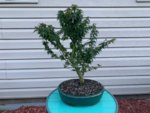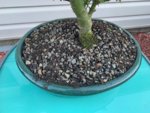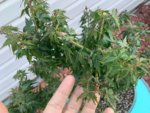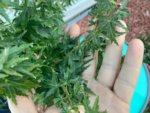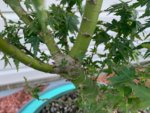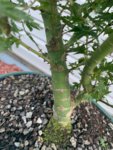Welcome to a fantastic life long hobby. Your tree is an excellent japanese maple (JM) to start with. The full technical name is Acer palmatum 'Koto Hime' with single quotes around the cultivar name. Every 'Koto Hime' is genetically identical to every other 'Koto Hime' all came as cuttings or grafts or air layers from the original seedling named 'Koto Hime'. It has a characteristic dwarf foliage pattern, there are other JM that include 'Hime' in their names, which signifies the dwarf pattern. All 'Hime' types are dwarfs, not all dwarfs are 'Hime'. Just trivia you can tell your girlfriend to show you appreciated the gift and looked up a little history on it. Most of the 'Hime' types are not quite as cold hardy as the normal forms of JM. I would consider 0 F, or -17 C to be the lowest temperature they will tolerate.
I am near Zion, Waukegan, Winthrop Harbor area, probably a bit north of you but basically the same climate. I am close to the lake, but with maples that doesn't change things much. Japanese Maples, all Acer palmatum, are not quite fully winter hardy in our area. In the ground some cultivars are hardy enough as landscape trees, but once put into a pot, nursery can or bonsai pot, they are not fully hardy and must be protected.
@derek7745 gave you good solid info as to the technicalities of wintering in Chicago. I'd like to add a few thoughts.
1. - it takes about 2 months for a tree to fully develop their physiological changes necessary to put up with a Chicago winter. Brussel's is much warmer than we are, USDA zone 7, probably zone 7b, where their coldest might only be +10 F and only for a few minutes. (thats -12 C). We on the other hand frequently have -17 F and for 8 hours or more at a time and can go 5 days to a week without rising above 0 F. (-27 C for 8 hours at a stretch, and below -17 C for weeks).
For the next month, move the maple into the unheated garage anytime it drops below +29 F. Only allow the tree to experience a degree or two of frost. You do want the maple to experience as many as possible nights in the 30's, it is the exposure to the 30's that will build cold tolerance. Fortunately we can usually get to almost Thanksgiving, end of November, without a prolonged freeze. Most days will be above freezing.
2 - Once the serious weather sets in, sometime in December, since you only have one tree, one trick I've used is pick up a cheap, but large enough to hold your tree - styrofoam beer cooler. Set the tree in the cooler. Then take as many half full plastic water bottles, with caps closed. The water bottles will provide thermal mass. Goal is to freeze once and stay frozen or to hover just above freezing without daily swings up and down in temperature. Close up the beer cooler and set in your unheated garage. Put on the cool end of the garage until weather outdoors drops near zero, then move the styrofoam cooler to the warmest part of the garage. Or move the cooler to the crawl space under the house. Check in the box at least weakly, make sure the soil the tree is in doesn't get too dry.
Pick up a couple thermometers, I have one that looks like a meat thermometer, but it reads in the range we are interested in -25 thru + 130 F. Stick a thermometer in the box with the maple. When you check you want to be sure the temp is below 40, and above 0F. As spring approaches it is critical to keep the inside of the box below 40 F. JM will sprout quickly, with just a few days above 40 F once their dormancy requirement is met. If it sprouts early you will have to begin the ''in and out dance''. Bringing the tree into the sun during the day and protecting from freezing at night. Also, when you bring them out of dormancy, maples want to go into medium shade. Direct sun for more than a couple hours can burn up new tender growth. Since they have the tendency to leaf out before out trees in the landscape leaf out, the ''shady spot'' in the back yard might have full sun and be too bright. So shade your maples as they break dormancy, but they do want fairly bright light. Brighter than what you could give them on a windowsill indoors or indoors under lights.
When maples have woken up early on me, I have moved them to my lights set up I use for my orchids, The new growth is somewhat leggy, often I end up pruning that growth off a month later after the tree is outside and growing.
Sounds complicated, but once you get the hang of things, it isn't too difficult handling JM in our inhospitable Chicago climate.

